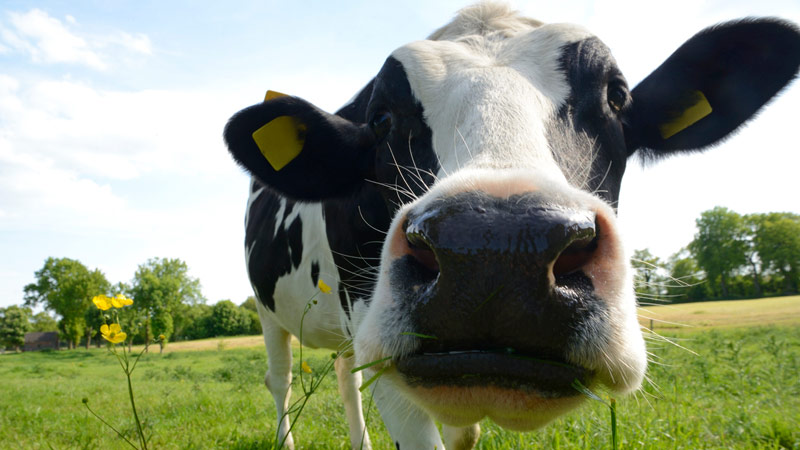Manure Into Money: The Magic of Entrepreneurial Thinking
Every day a dairy cow makes a mountain of manure. An average cow excretes a staggering 120 pounds of feces and urine daily, and that means odors, which leads to complaints. Then there are complaints about the methane emissions associated with cow manure. The average cow produces 250 to 500 liters of methane a day. And experts say cutting methane is a key in today’s climate fight.

Dairy cow manure — and know there are over 9 million dairy cows in the US — is a problem, except maybe it isn’t.
Just maybe it is a source of real profits for entrepreneurial dairy farmers who are finding ways to transform manure into money in their pockets while also solving genuine consumer problems in their communities.
Remember that old saying, when life hands you lemons, make lemonade? That’s exactly what dairy farmers and researchers around the country are doing as they hunt for ways to monetize poop.
‘What’s Worth More, Milk or Poop?’
Aaron Smith, the DeLoach Professor of Agricultural and Resource Economics at the University of California, Davis, asks exactly that provocative question in a probing online paper where he concluded: “the cow's milk is worth more than its poop, but the poop is worth a lot.”
How can that be? It starts with a machine called a digester that was invented in 1859 at a leper colony in India, where the goal was to take waste and use it for both lighting and cooking. In the late 19th century, the concept migrated to England, where human waste was used to power street lamps.
The basic idea is to take waste and extract the useful methane gas (it can be used most places where natural gas is) — that is value from nothing. Microbes — bacteria — do the transformation work, and they are plentiful.
The technology works, no question, but for a long time, it remained something of a curiosity, probably because of widespread reluctance to deal with manure at all. Then two things happened.
First: the manufacture of the devices got slicker, especially in the post-World War II era, and digesters could be made bigger and bigger. Here are the dimensions of a digester at an 800 cow dairy in Vermont: “The digester measures 72 feet wide by 96 feet long by 16 feet deep, and is a U-shaped configuration. It holds almost 800,000 gallons.” (For context, a typical home swimming pool holds around 13,500 gallons.)
This sets the stage for the second development: dairy farms have gotten bigger as farmers seek economies of scale. When a farmer milked a few dozen cows (as was customary 50 years ago), it was easy to put the manure to use on the farm, mainly as raw fertilizer. But today’s farms often involve thousands of cows. The Threemile Canyon Farm in Oregon, for instance, milks 33,000 cows.
Huge farms create a demand for today's digesters. The topline benefits are that usable energy is made and odors are minimized — dramatically reducing the smell complaints filed with local governments.
The Money Problem
Digesters can do still more, but know that they work well, and the only hitch is the price. The cost of a digester for a typical dairy farm — a few hundred cows — will be around $1 million, estimated Pete Wright at Cornell University in New York. Machines to work this magic at a state-of-the-art megafarm of 7500 cows and up are multiples more.
But there is good news. “This is becoming economically feasible,” said Daniel Andersen, an associate professor in the Dept. of Agriculture at Iowa State. The reason: from Vermont to California, states are making financial supports available for farmers to buy digesters. Federal supports also exist.
Anderson admitted that as solar gets better and cheaper at energy production, that narrows the argument for digesters. But just maybe the many other benefits of digesters tilt the argument in their favor, at least in the states where dairy matters, such as California and Wisconsin.
At Blue Spruce Farm near Bridport, Vermont, the Audet family milks around 1,300 cows — about 156,000 pounds of daily manure. That manure is collected and pumped into their digester, where the methane gas floats to the top, and it in turn is put into the local energy grid, where it creates enough power for 300 homes.
But that’s just the beginning. In a 21-day process, liquids are separated from plant fibers in the manure, and the fibers are used to create odor-free bedding for the Blue Spruce cows. That replaces a tractor-trailer load of sawdust the Audets used to buy weekly for their cows. The farm tells the benefits: “This contributes to our carbon reduction simply by keeping a tractor-trailer off the road to our farm and by reducing our trips to the fields to spread that amount of sawdust with our manure-based fertilizer. Because we have plenty of bedding, we use more than ever, keeping our cows extra comfortable.”
The Audets use about half the bedding on their own farm; they sell much of the rest to other dairy farms.
Liquids that remain are put to use to fertilize the Audets’ land, which helps produce more food for the cows.
Call that a problem solved (and solved again). In Buckeye, Arizona, 55,000 daily tons of manure from some 25,000 cows at the Butterfield Dairy will be transformed into 3 million therms per year which will be the equivalent of taking 3500 cars off the roads. That facility is slated to be operational by year-end.
Across the country, many hundreds of similar energy-producing operations are popping up as the planet looks for ways to minimize methane’s negative environmental impacts and also for comparatively clean, renewable energy sources. Cow manure checks all the boxes. “We will never get all our energy from manure,” said Professor Anderson. “But it will be part of the picture.”
Super-Charged Fertilizers
There’s one more safe bet when it comes to monetizing manure: the stuff makes for extraordinarily good fertilizer. Michigan State University Associate Professor Dana Kirk, who runs the campus’s digester, says, “renewable fertilizers are what’s exciting. The demand from agriculture is huge.”
A proof is the line of Moo products created by the Fosters Brothers Farm in Vermont, where over 400 cows produce, in addition to milk, Moo Doo, a much-praised fertilizer that is sold at many garden stores in the Northeast.
These kinds of natural, sustainable fertilizers are striking a loud consumer chord in today’s society, and the reality is that cows will keep on pooping, so the supply of this super-charged manure is plentiful.
But ingenuity regarding manure transformation is flourishing. In New Canaan, Connecticut, Freund’s farm — with around 300 dairy cows — is taking a different approach to manure, one that has even been featured on Mike Rowe’s cable TV show “Dirty Jobs.” Farmer Matt Freund invented CowPots, which are biodegradable seed starter pots made out of odorless solids that are left after manure is run through a digester.
Along the way, the Freunds produce methane to power their farm.
CowPot Ingenuity
But it is the CowPot that is the star of this show. Freund has been perfecting his invention for 20 years, said his daughter Amanda who works with her father on the CowPots, which are intended as a superior replacement to the traditional peat pots used by gardeners and farmers. The problem with peat pots is that they do not quickly biodegrade — meaning the pot stays intact long after the gardener wishes it had degraded in the soil.
CowPots, said Amanda Freund, are available in many garden supply centers. She added, “This work has meaning. It is providing an alternative to peat and plastic.”
The Freunds and their CowPots are outliers, but they are outliers that prove a point: manure has many paths to money.
There will be other discoveries -some researchers now believe manure can be transformed into paper, for instance. Will there be false starts? That always happens with startups in any field. Manure is no exception. Experts point to research 20 years ago at Iowa State that suggested fiber in manure could become a mainstay in making the fiberboard used for construction. “That did not take off,” said Wright.
But the takeaway is that, right now, scientists are in the hunt for ways to transform manure into money — and there are plentiful reasons to believe some of these ideas will click. That’s good for the farmers and good for the planet. It’s a win-win out of lemons.
About the Author

Robert McGarvey, a veteran journalist who has long covered startups and small businesses, created and hosts the CU2.0 Podcast for credit union and fintech executives which is at 120 episodes and counting.
Startup Resources
- Learn more about Startups
- Visit the TRUiC Business Name Generator
- Check out the TRUiC Logo Maker
- Read our Business Formation Services Review
- Find Startup Ideas
- Explore Business Resources
Form Your Startup
Ready to formally establish your startup? Click below to read our review of the best business formation services!
Best Business Formation Services